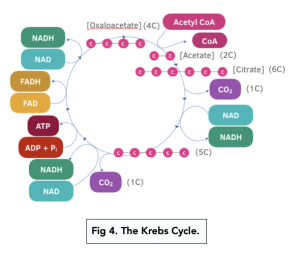The Krebs Cycle (A-level Biology)
The Krebs Cycle

Overview
Each molecule of Acetyl-CoA formed during the link reaction enters the Krebs Cycle, which takes place in the mitochondrial matrix.
For every molecule of glucose that undergoes glycolysis, two Acetyl-CoA are made in the link reaction, and therefore two rounds of the Krebs Cycle occur (one for each molecule of acetyl-CoA).
Stages of Krebs Cycle
The following steps are in terms of 1 acetate molecule. But there will be two acetates per glucose molecule.
- The acetate is released from CoA. CoA is used to transport acetate from the link reaction to the Krebs cycle. As soon as the Krebs cycle begins, acetate is unloaded.
- Acetate joins with oxaloacetate. Acetate (2C) combines with oxaloacetate (4C), forming a 6C molecule called citrate.
- Citrate is decarboxylated and dehydrogenated. Citrate (6C) loses a carboxyl group and forms a 5C molecule, releasing CO2 in the process. It also loses two hydrogens, which are accepted by NAD to form reduced NAD.
- The 5C molecule is decarboxylated and dehydrogenated. The 5C molecule is also decarboxylated and dehydrogenated, forming a 4C molecule. Again, NAD accepts the lost hydrogen, forming another reduced NAD.
- The first 4C molecule is converted to a second 4C molecule. The 4C molecule undergoes a reaction, changing to another 4C molecule. In the process the original 4C molecule gives a phosphate group to ADP, leading to production of ATP. This is substrate-level phosphorylation, as the 4C compound (substrate) is phosphorylating ADP during the reaction.
- The second 4C molecule is converted to a third 4C molecule. The second 4C is converted to another 4C molecule. Two hydrogens are released, and accepted by FAD, making reduced FAD.
- The third 4C molecule is converted to oxaloacetate. The third 4C is dehydrogenated. This re-forms the oxaloacetate, completing the cycle. Another pair of hydrogen atoms are released, making reduced NAD.

Products of Krebs Cycle
The reduced NAD and reduced FAD produced in the link reaction and Kreb Cycle are important for the final stage – oxidative phosphorylation.
Per molecule of glucose (and hence per 2 molecules of acetyl-CoA) Kreb’s cycle produces:
- 2 ATP – some energy is produced in the form of ATP.
- 6 reduced NAD – just like the reduced NAD from the previous two steps, the reduced NAD from the Krebs cycle goes to oxidative phosphorylation.
- 2 reduced FAD – the reduced FAD joins reduced NAD in going to oxidative phosphorylation.
- 1 coenzyme A – this goes back to the link reaction where it can be used to transport another acetate to the Krebs cycle.
The Krebs Cycle, also known as the citric acid cycle or the tricarboxylic acid cycle, is a series of chemical reactions that occur in cells to produce energy from the oxidation of acetyl-CoA derived from carbohydrates, fats, and proteins.
The main function of the Krebs Cycle is to produce energy in the form of ATP (adenosine triphosphate) through the oxidation of acetyl-CoA. The ATP produced by the Krebs Cycle can be used by the body for various functions, including muscle contraction and the transport of substances across cell membranes.
The main steps of the Krebs Cycle include the conversion of acetyl-CoA to citric acid, the series of chemical reactions that occur to produce energy, and the production of carbon dioxide as a waste product.
The Krebs Cycle interacts with other metabolic pathways, such as glycolysis and the electron transport chain, to produce energy for the body. The products of glycolysis are converted into acetyl-CoA, which then enters the Krebs Cycle, and the energy produced by the Krebs Cycle is used by the electron transport chain to produce ATP.
Enzymes play a crucial role in the Krebs Cycle by catalyzing the reactions that occur. They speed up the reactions and ensure that the Krebs Cycle runs smoothly and efficiently.
No, the Krebs Cycle cannot occur without oxygen. Oxygen is required to complete the electron transport chain and produce ATP, which is a key component of the Krebs Cycle.
If there is a deficiency in the enzymes involved in the Krebs Cycle, the reactions may not occur efficiently or at all. This can result in a buildup of toxic substances and a decreased ability of the body to produce energy, leading to a variety of health problems.






Still got a question? Leave a comment
Leave a comment